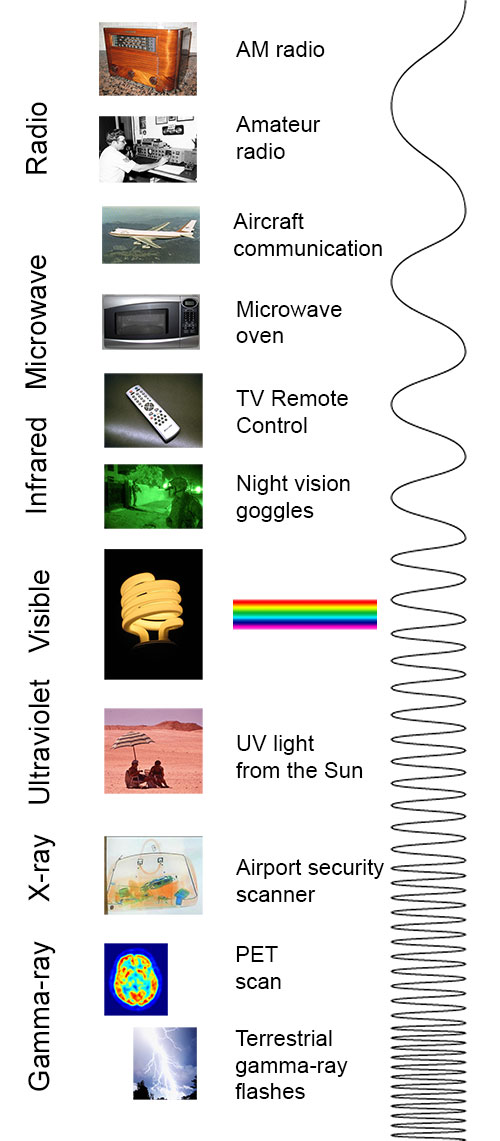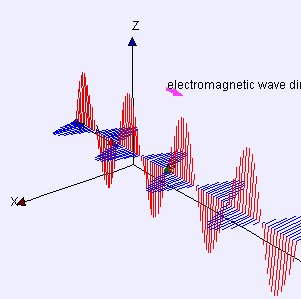Study Guide: Electromagnetism
- Electromagnetism: A fundamental phenomenon of nature that seems to be a combination of two fields—the electric field and the magnetic field.
- Michael Faraday
- James Clerk Maxwell
- Heinrich Hertz
- Guglielmo Marconi
The electromagnetic force is a mysterious field that is essential to everything we know. It seems to be composed of two fields—the electric field and the magnetic field.
We understand surprisingly little about electromagnetic energy, despite the fact that we are utterly reliant on it for everything from the electrical impulses in our brain and nervous system to global wireless communication systems. It holds all matter together. It causes all chemical reactions, and it creates the visible radiation that we call light and color.
Electromagnetism is one of the four fundamental forces (or interactions) of nature, which include the strong interaction, the weak interaction, and gravitation).
Fear and Precaution
Are the mysterious forces of electromagnetism safe? Like all mysterious forms of energy, we should be careful about using something we do not understand.
For example, when people switched from gas lights to electric lights, there was widespread fear about using the new technology.
In 1891, electric lighting was installed in the US White House for the first time. In those days, electric lights were barely a decade old and few people had faith in the new technology. However, US war planners saw new uses for electricity, and promoted the lighting of the White House as a way to increase popular support for their own efforts.
The electrification of the White House was part of a well-funded military project to wire up the State, War and Navy Building next door. The Edison Company installed a generator for both buildings inside the State, War and Navy Building’s basement. Wires were then strung across the lawn to the White House. (Note: This was before the invention of “propaganda”, after which “war” was renamed “defense”.)
The electric lights were initially only meant to supplement the more reliable-seeming gas and candle lights. Wires were buried in wall plaster, with round switches installed in each room for turning the current on and off. President and Mrs. Harrison refused to operate the switches out of fear of being shocked. They left the dangerous task to the domestic staff. Unfortunately, history does not record the opinions of the “domestics” who braved the mysterious new technology.
Like the almost forgotten fear of electric lights, fear of other uses of electromagnetic energy is widespread today. Many today are concerned about electromagnetic radiation from radar systems, microwave ovens, cell phones, wireless networks, Bluetooth devices, x-ray equipment, 5G networks, etc.
Despite the fears–both valid and invalid–a few intrepid explorers forged on…
Discoverers of Electromagnetic Energy
Michael Faraday
 Michael Faraday was one of the most famous scientists in history, and is known as the ‘Father of Electricity’. He was born September 22, 1791 in London, England, UK and died August 25 in 1867 at the age of 75. His father was a blacksmith. Before they married, his mother had worked as a servant. England was a tough place for the poor, and they lived in great poverty.
Michael Faraday was one of the most famous scientists in history, and is known as the ‘Father of Electricity’. He was born September 22, 1791 in London, England, UK and died August 25 in 1867 at the age of 75. His father was a blacksmith. Before they married, his mother had worked as a servant. England was a tough place for the poor, and they lived in great poverty.
Sir Humphrey Davy was one of Michael Faraday’s heroes. When Davy had an unfortunate accident in his lab, he asked Michael to work for him by writing his lab notes. This was a dream come true for Faraday. Davy soom saw the boy’s potential, and made him chemical assistant at the Royal Institute. As the years went by, Faraday was promoted, and eventually became a full professor.
James Clerk Maxwell

James Clerk Maxwell began by investigating the work of other scientists. Faraday’s understanding of mathematical fields gave him the insight to describe electromagnetism with field equations, which led to more discoveries by many others.
Classical electromagnetic field theory emerged in more or less complete form in 1873 in Maxwell’s, “A Treatise on Electricity and Magnetism”. Maxwell based his theory on the intuitive insights of Michael Faraday, but was able to more accurately describe and prove them using mathematics. The wide acceptance of Maxwell’s theory caused a fundamental shift in our understanding of physical reality, leading in time to the revolutionary ideas of Einstein and others.
Heinrich Hertz

Heinrich Hertz (1857-1894) was one of the most important scientists of the nineteenth century. The famously self-effacing physicist was responsible for, among other things, the discovery of the photoelectric effect, which helped form the foundation for modern quantum theory. Hertz also discovered radio waves, which have numerous modern communications, wireless technology, astrophysics and medicine. To honor Hertz, a consortium of scientists gathered in 1930 and named the unit of frequency after him.
Heinrich Hertz began by studying Maxwell’s work, in particular, the mathematics behind the explanation of electromagnetic energy. Hertz designed the laboratory equipment needed to investigate the physical reality of Maxwell’s equations. His experiments proved that Maxwell and Faraday’s ideas about electromagnetism were correct.
$$ \textit{Hz } = \textit{ Hertz } = \textit{ Cycles per second} $$Guglielmo Marconi

Guglielmo Marconi, was an inventor who built on Hertz’s work to develop transmitters and receivers. He began the era of global wireless communications using Morse Code. With his work, the stage was set for the modern era of communications. All it took was the invention of the electron tube, the magnetron, the traveling wave tube, the transistor, the integrated circuit, and a variety of computer technologies to bring us our current world of $24 \times 7$ instant global communications.
What is an Electromagnetic Energy Wave?
An electromagnetic energy wave is a complex form of energy composed of oscillating electric and magnetic fields joined together and capable of conveying energy through space to the matter it meets.
By Lookang many thanks to Fu-Kwun Hwang and author of Easy Java Simulation = Francisco Esquembre - Own work, CC BY-SA 3.0, https://commons.wikimedia.org/w/index.php?curid=16874302
The Electromagnetic Spectrum
The electromagnetic spectrum is the range of all types of electromagnetic radiation. Radiation is energy that travels and spreads out as it goes—the visible light from a lamp and the radio waves a radio station are two types of electromagnetic radiation. The other types of electromagnetic radiation are microwaves, infrared light, ultraviolet light, X-rays and gamma-rays.

Radio: Radio captures radio waves emitted by radio stations. Radio waves are also emitted by stars and gases in space.
Microwave: Microwave radiation cooks popcorn in minutes, but is also used by astronomers to learn about the structure of nearby galaxies.
Infrared: Night vision goggles pick up the infrared light emitted by our skin and other warm objects. In space, infrared light helps us map the dust between stars.
Visible: Our eyes detect visible light. Fireflies, light bulbs, and stars all emit visible light.
Ultraviolet: Ultraviolet radiation is emitted by the Sun and is the cause of skin tans and burns. “Hot” objects in space emit UV radiation as well.
X-ray: A dentist uses X-rays to image our teeth, and airport security uses them to see through our luggage. Hot gases in the Universe also emit X-rays.
Gamma ray: Doctors use gamma-ray imaging to see inside your body. The biggest gamma-ray generator of all is the Universe.
How does electromagnetic energy behave?
Electromagnetic energy follows predictable patterns from the moment it is formed to the the moment it meets matter. These patterns can be defined with mathematically precise equations.
One fact (or pattern) that all the equations have in common is that what the energy does to the things around it is dependent on the wavelength or frequency of the wave. Exactly how each physical object or living being is affected by electromagnetic energy is completely depending on how that particular object blocks and interacts with particular electromagnetic waves.
An obvious example is our eyes. We see visible light because our eyes are designed to capture wavelengths of that specific size. All other wavelengths are completely invisible to us.
On the other hand, visible light passes through clear glass without affecting the glass. Colored glass contains chemicals that absorb or reflect visible light at specific wavelengths while letting other wavelengths pass through undisturbed.
When electromagnetic energy reaches matter and is partially or totally absorbed by it, the electric and magnetic characteristics of the matter determine how much and at what frequency the energy is absorbed.
This can be seen by the absorption of electromagnetic energy in the atmosphere by oxygen, carbon dioxide, and other gases, which gives our atmosphere its color and warmth.
Absorption of electromagnetic energy is also affected by the length of whatever the wave meets. If the height of a person is close to the wavelength of the electromagnetic energy, resonance enhances the absorption of electromagnetic energy. This is why the length of a radio antenna is important. Each antenna is designed to absorb specific wavelengths and frequencies.
The Mystery Remains
It is important to remember that, except for visible light, the electric and magnetic fields are the only two phenomenon that enable us to study something that is otherwise completely invisible to us. It is the measurement of these fields (whatever they are) that allows us to “see” an underlying force of nature.
Although we have developed many beautiful theories to explain this reality in which we find ourselves, the actual cause of light, electricity and magnetism remains completely mysterious to us.



